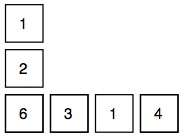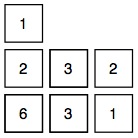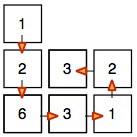Copyright © University of Cambridge. All rights reserved.
'Taking a Die for a Walk' printed from https://nrich.maths.org/
Show menu
We often roll a die to find a number from $1$ to $6$ for a game that we're playing. We wait until the die stops and then see what number is on top. What about if we slow it down and have the die slowing rolling along? What if we make it even slower and we move the die to a new face one at a time?
In this way we can move the die forward/backward or right/left. You might like to think about it as North, South, East or West.

You can then move the die around and take it on a journey. In this investigation, we're going to think of a journey as never re-visiting a place where the die has already been. So it can't cross back over its path or go back over where it has just been.
When I first thought about this I thought of the die leaving a kind of "footprint" of the bottom number wherever it went on its journey. You can do this if you want to.
I then found it easier to look at the number on the top as each new "step" was taken.
So with a die which might show:-
![]()
- or maybe you have one with numbers on it:-
![]()
we can go on a little journey:-

So, starting with $1$ on the top we move down. (I make sure that $2$ is going to come up by moving the die around before starting.) I then got $2$ followed by $6$. I then rolled it over to the right a few times. $3$ shows up, then $1$ again, followed by $4$.
Another journey could be:-

We start off as before. But, when I've rolled to the right a couple of times, I go up and it shows a $2$, and then left and it shows a $3$. It's a bit difficult to see where I've gone so I've added an arrow to show the direction.

What I CANNOT do now it to go further by rolling left from that last $3$ which would give a $5$ on top of the $2$ I had from my first step. Remember - no crossing back again!
So, explore a little and see what things happen as you roll around different paths and you write the numbers down.